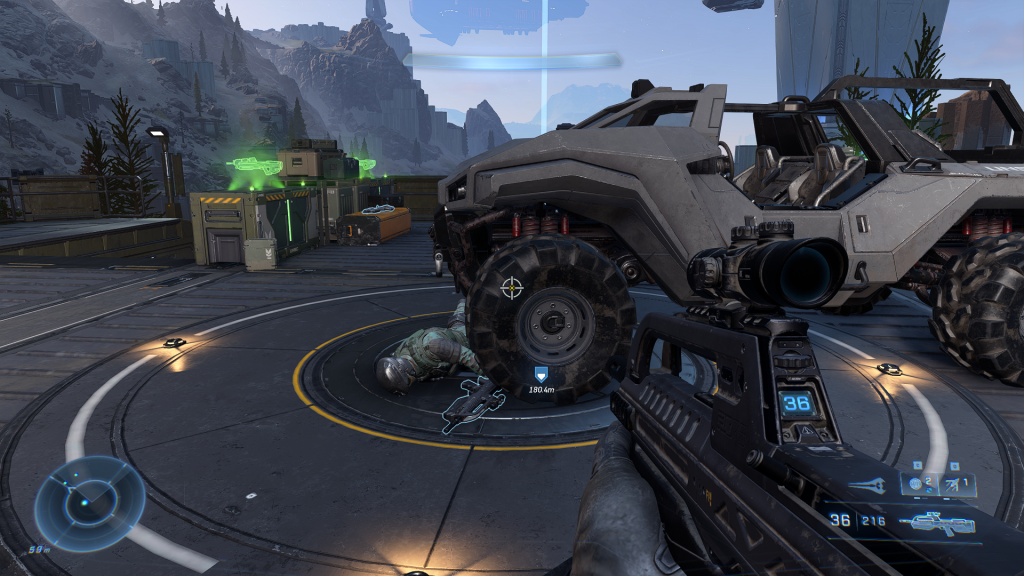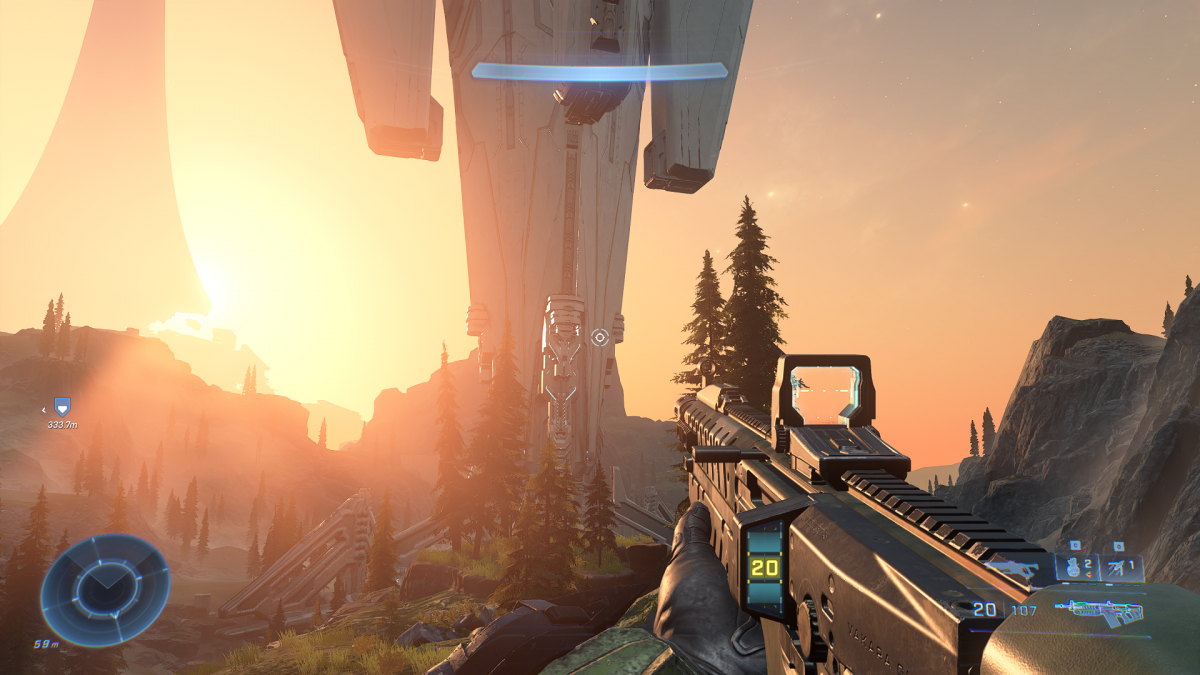Looking for the Quick Review?
Halo Infinite is, in several ways, an incomplete game. Compared with previous Halo titles, it feels lighter, not nearly as jam-packed with gamemodes and features. To its fortune, the pieces its developers prioritized are the most important, the critical components that establish Infinite as a (tentatively) great game and a significant step forward for the series.
First, the painful blows: this is a game that launched without Forge, the mapmaking mode introduced in 2007’s Halo 3 and included in every title since. More critically, it launched without a cooperative campaign mode, a feature present since the series’s first chapter, Halo: Combat Evolved, and, to many, a Halo staple.
These initial omissions, promised as content updates in the first half or so of 2022, are casualties of a game delayed more than once, originally intended as a system-seller for the Xbox Series S/X and now finally released over a year later. Their separation from the final product makes Halo Infinite feel incomplete, but their sacrifice has not been in vain; if pulling development resources from forge and co-op helped solidify the image of the solo campaign and multiplayer modes, it may have been the right decision.
As much as I’ve enjoyed it, the game that shipped in December is still far from perfect. Transitioning Halo‘s previously full-price multiplayer to a free-to-play model means relying on alternative means of monetization. In this case, players who download the game for free can decide to spend money instead on either cosmetic armor pieces, double EXP tokens, or challenge skip tokens (we’ll talk about these in a minute).
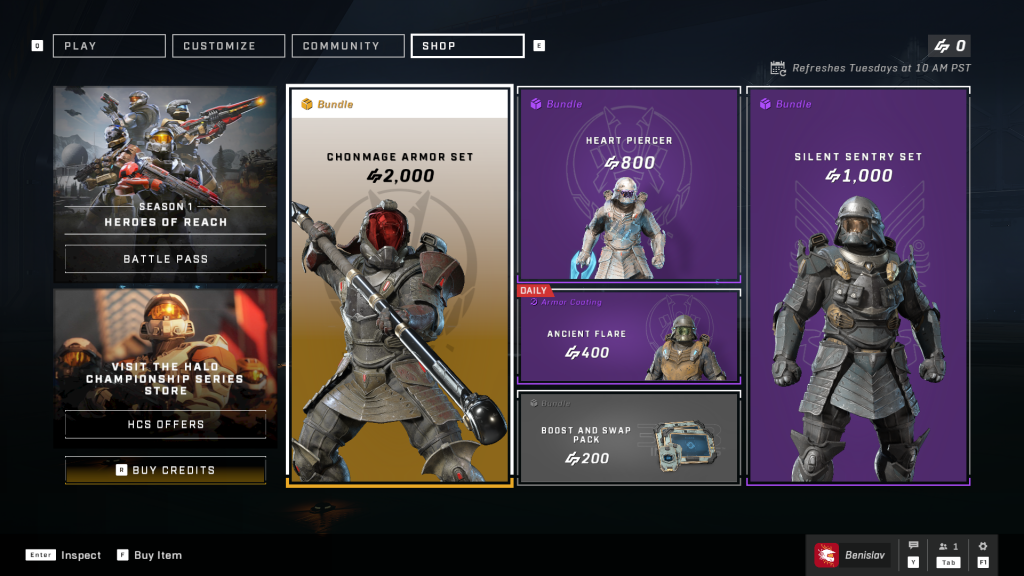
Player customization and progression are the two principal casualties of the free-to-play switch. Halo‘s previously open and highly-customizable character design systems have been restricted and progression is now tied to a Battle Pass infrastructure fully reliant on the completion of in-game challenges. The Battle Pass takes positively from its predecessor, Halo: The Master Chief Collection in that passes from any current or previous season can be bought and completed at any time (as opposed to the dominant model where all Battle Pass progression is tied to a season-long timer and rewards are no longer achievable at season’s end). But this implementation is predictably damaged by slow level progression that rewards players, not for kills or objective scoring, but instead for completing specific daily and weekly challenges. Most of these challenges aren’t particularly difficult, but their emphasis does alter the game by incentivizing non-objective gameplay. If your goal is to progress through the Battle Pass and all of your challenges require you to capture Stronghold Territories or get kills with a subpar weapon, you’re liable to either leave non-Stronghold matches or beeline one weapon regardless of how helpful it might be in the moment. These read as small modifications to the gameplay formula, but it should be emphasized that this is the only way to earn experience in the game; the only way the progression system rewards players who score points or win matches is when they have challenges to do so.
In other words, even if you couldn’t care less about cosmetics or experience points, the game’s matchmaking system will probably team you up with other players who do, making your team performance at least partially dependent on how kind RNG has been to them.
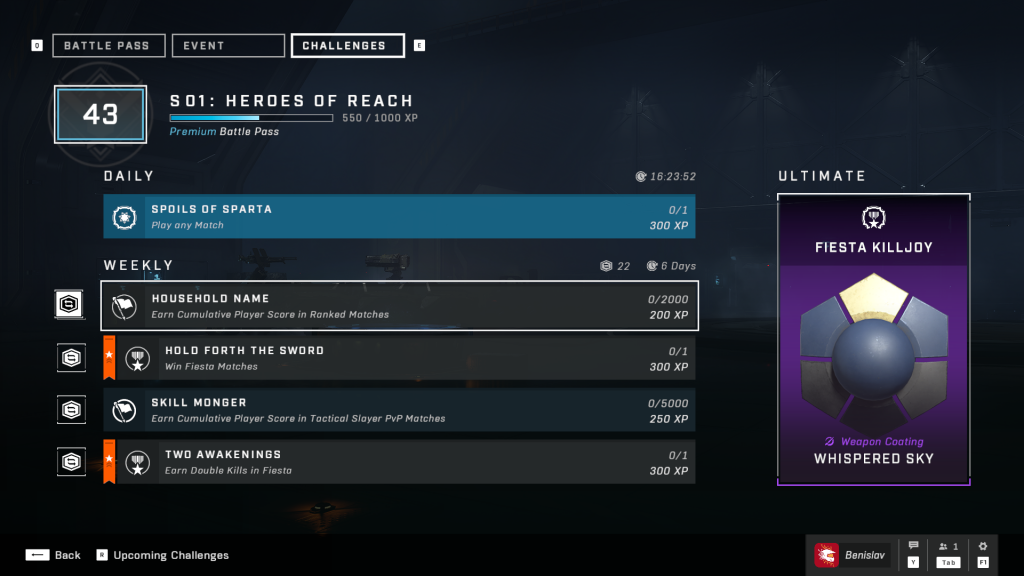
On the other hand, if you do care about armor pieces and experience points, but you’re not interested in completing frustrating challenges, the game has an answer for you: challenge skips. Any challenge you’re not interested in completing can be leapfrogged by consuming one of these. You’ll earn several just by progressing through the game’s battle pass, though I don’t know how many of the ones I’ve received are tied to the barely-superior $10 version. But if you run out and want some more, you’ll have to pay up.
As it stands, most of the challenges aren’t too arduous — it’s predominantly stuff like “kill 5 players with assault rifles” and “capture a territory” — but when the game launched, expectations were notably higher, and many players (righteously) wondered if this early level of difficulty was designed with the intent to coerce players into buying challenge skips.
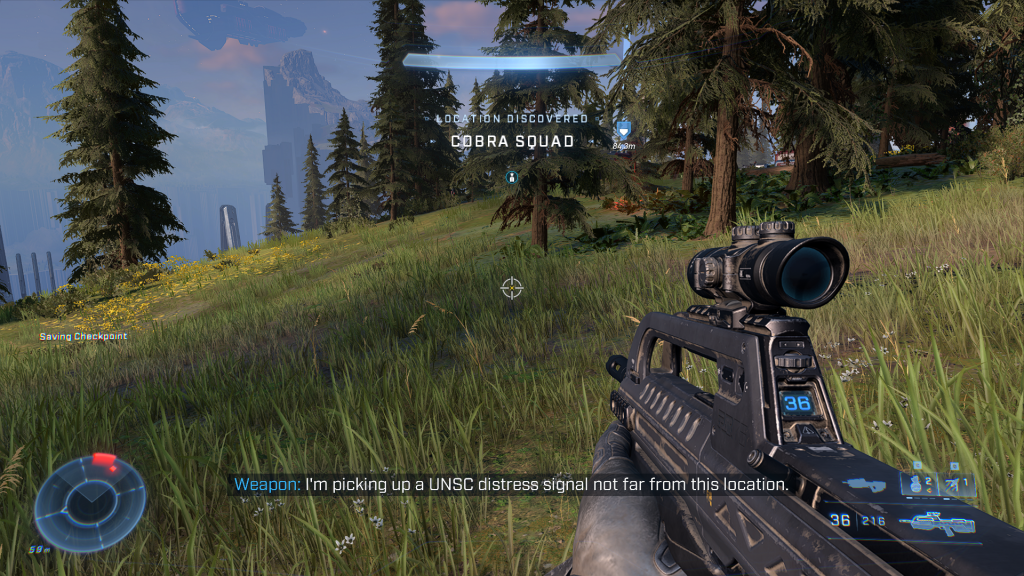
Implemented correctly, a Battle Pass system like this one can be innocuous, if slightly inferior to the progression systems of yesteryear, but Halo Infinite’s bears fewer similarities to its predecessor’s (Halo: The Master Chief Collection), and more to the familiar mobile game model of creating a problem and then charging players for the solution. Everything in the challenges system seems designed to be slightly more frustrating than necessary.
Stepping beyond progression, players have also expressed dissatisfaction with the game’s playlist system. Where previous titles launched with separate Slayer (Deathmatch), Team Slayer, and Objective playlists, Halo Infinite’s playlists separate only Ranked (its ranked competitive mode), Quick Play (standard 4v4 matchmaking) and Big Team Battle (12v12 matches on larger maps). Objective game modes like Capture the Flag and Oddball were mixed in inextricably with deathmatch modes. In subsequent communications with the game’s community, 343 has argued that the decision to combine game modes into fewer playlists came in the interest of streamlining gameplay and guaranteeing healthy populations for all game modes. More critical player opinions have questioned that system’s interaction with the aforementioned challenge system, where challenges to complete specific game modes are tied directly to the rarity of those game modes in matchmaking.
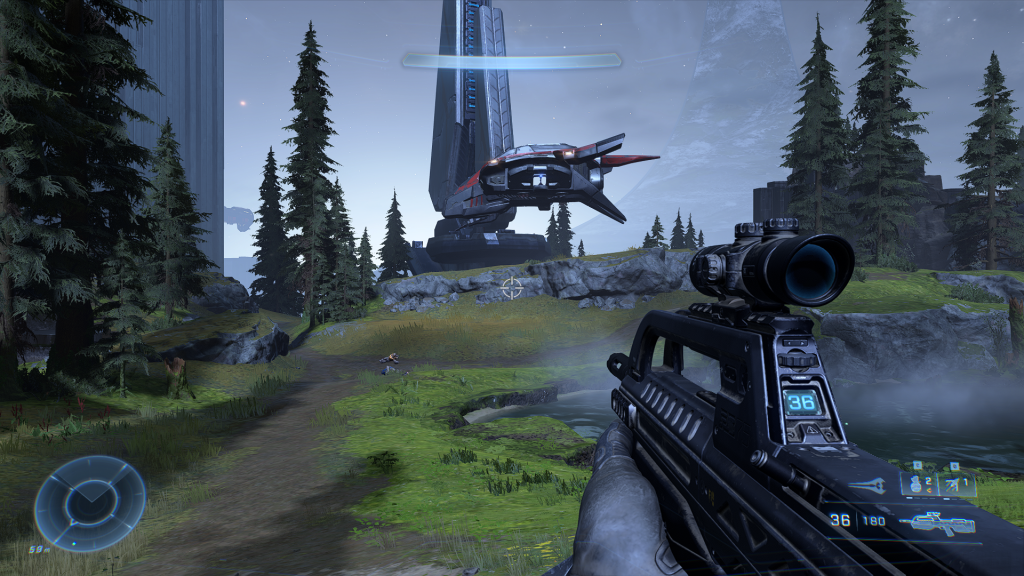
Following criticism of the playlist rollout, 343 has partially remedied the issue by introducing several Slayer-focused playlists, but those interested in Objective modes remain tied to a Quick Play playlist that still includes Slayer. Excuses have been supplied, but after the Master Chief Collection‘s superb selection of game modes, it’s hard to believe this couldn’t still be done better.
Given that 343 has clearly put some effort into remedying the problem, the fairest response might be to attribute these shortcomings to internal misunderstandings. But there’s a thread that starts with the progression system and keeps winding through this new topic. If you’ve got a challenge to win a game of Capture the Flag, and you have the ability to choose to play Capture the Flag, you can reliably expect to complete that challenge relatively quickly. But if it’s hidden in a pile with every other game mode, it’s going to take significantly longer.
I don’t like coating myself in tin foil, especially for a review, but Halo Infinite’s bizarre multiplayer design necessitates it. The playlist system in The Master Chief Collection, at least the one in place when the game made it to PC, was famously well-crafted. Everyone I talked to loved it, and it seemed like the response online was similar. The game’s progression system was similarly impressive. 343 knew how to craft a multiplayer shooter. Then, suddenly, with the switch to free-to-play, all that knowledge disappeared.
The Good
I’ve dedicated a lot of space to criticism so far, prepared to feed into the “awful game, awful controls, 9/10” reputation that games journalism sometimes earns. But my harshness toward Infinite doesn’t come from a place of disdain. We share more of a ‘jaded student and English teacher who just wants their pupil to work toward their full potential’ vibe.
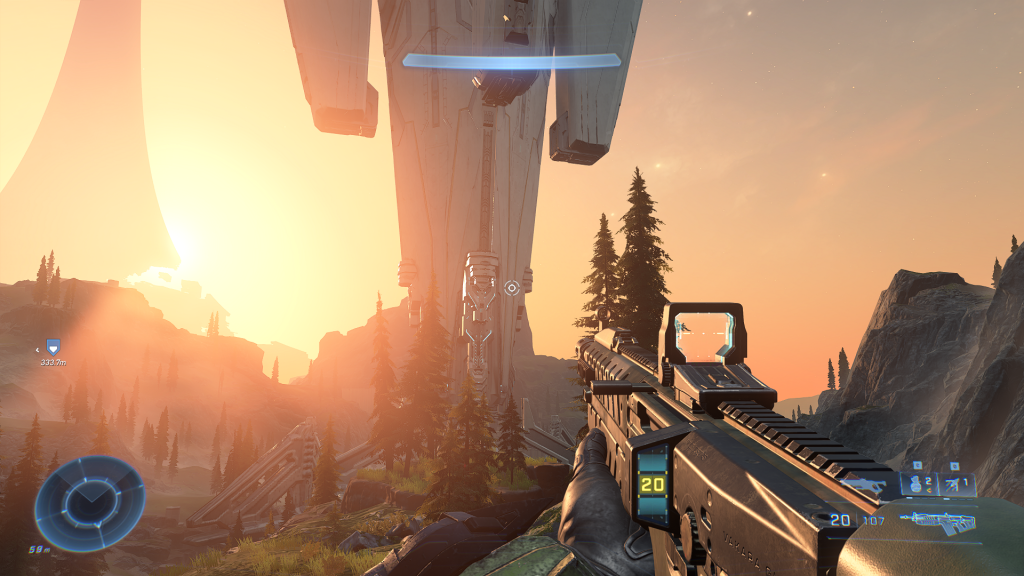
Where Infinite succeeds, it excels. Multiplayer feels authentically Halo but manages to step away from resting too heavily on its laurels with innovative new weapons and equipment. That equipment is the real victory here (specifically one piece of equipment). With Halo 3, Bungie made its first effort to augment the golden triangle of shooting, melee, and grenades with equipment items like the Bubble Shield, which featured heavily in the game’s promotion. While some of these newly-introduced equipment items turned out to be moderately useful (Bubble Shield, Power Drain), others were either underpowered (Trip Mine, Radar Jammer, Deployable Cover, and Flare), or underutilized (Regenerator, Gravity Lift). Reach found more success with its armor abilities, but as fun as jet packs were, abilities like sprint and armor lock have been divisive among Halo fans.
Before I make my big point, I have to acknowledge, to myself and to you, that Infinite‘s equipment suffers from much of the same issues as its predecessors: the Threat Sensor, for example, has potential to be a useful tool in games where skilled players are willing to work together to utilize the information it provides. In your everyday Slayer match, it may as well be invisible. Similarly, while the Thruster expands the player’s range of mobility and combat options in a gunfight, it takes some adaptation to the new formula to recognize when you have it on you and react accordingly. That’s a problem across the board with these equipment items — Reach‘s armor ability had you select your playstyle from the spawn menu. Infinite‘s equipment asks you to be ready for whatever it throws at you, which is exciting, but also takes away opportunities to practice and get used to a particular item.
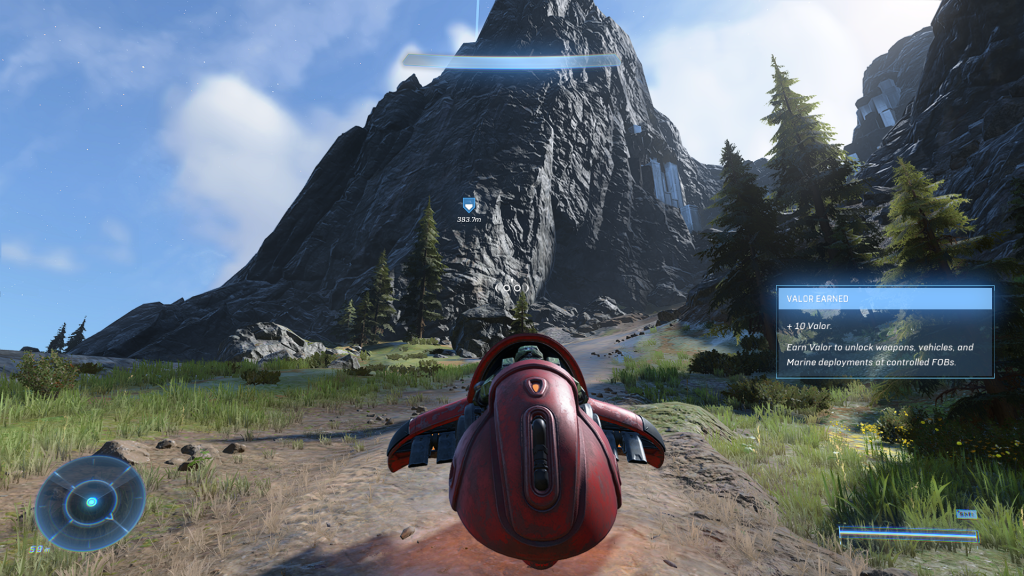
Of the game’s other equippables, some are relatively simple, but effective, like the Drop Wall (a temporary one-way shield) and the Repulsor, which knocks enemies (and, usefully, projectiles) backward. Others modernize old-school map-based power-ups like overshields and active camouflage by making them strategically activatable items, allowing players to select when they utilize their powers.
And then there’s the grappleshot. The grappleshot changed how I play Halo. When I pick it up in a multiplayer match, the adrenaline flows. When I die and spawn without it, I feel nothing but heartwrenching loss. One of my first nights playing the campaign, I spent the better part of an hour zooming around the map with a fully-upgraded grappleshot before transitioning to a different game with friends. I still saw every ledge as a potential grapple target, still found my eyes searching for trees and other high-up surfaces I could use to retain my mobility, my experience as a 1-ton spiderman still fresh in my memory.
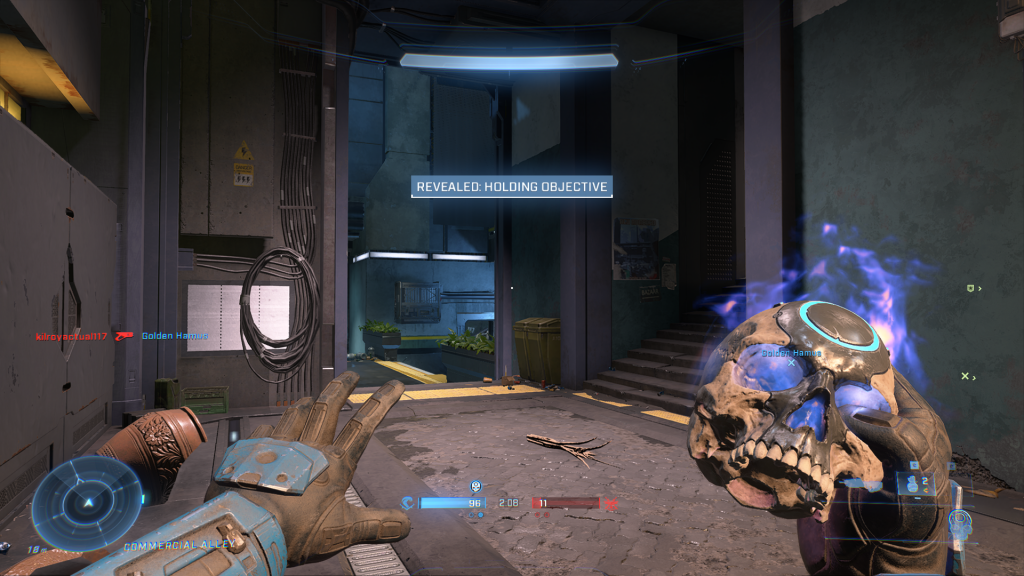
One of Infinite‘s difficult-to-overstate franchise victories is the addition of pretty solid multiplayer bots. Being able to play practice matches against teams of bot enemies before going up against other players is one benefit of this system, but the big one is partial balance for quitters in online matches. Replacing departed teammates with bots is hardly an industry innovation, but thinking back to Halo 3 (where a quitter’s slot on the team was never filled, leaving you to finish the match at a heavy disadvantage), it’s a welcome sight. With bots, a teammate or enemy disconnecting doesn’t throw the balance of the game into complete flux. Of course, they’re not that good, but Infinite also has a backfill system, so we can say the disadvantage has, at the very least, been tempered.
Multiplayer’s strengths are difficult to pick apart and identify because asking me to do that is asking me to go through what makes any Halo game great. These games, to me, are native experiences, some of the first games I fell in love with. What makes Halo Infinite‘s multiplayer great is the same mixture of secret sauce that made Halo 3 great. Nearly a decade and a half out, it feels like this game took the largest part of its inspiration from that title, and it shows. If you loved Halo 3 as much as I did, there’s a very solid chance you enjoy this one too. At the same time, through the features I’ve already mentioned as well as a coat of 2021 polish, it’s far from stagnant. It feels like Halo built for today.
Campaign
One of Infinite‘s largest and most publicized departures from its predecessors is its open world. After an initial atmospheric tutorial mission, Master Chief lands on Installation 07, one of the massive, galactic super-weapon ring-worlds known as Halos. Unlike previous games, there’s no linear path laid before him. His right to roam is limited to a few islands, but (most of) those islands can be traversed in full and at will.
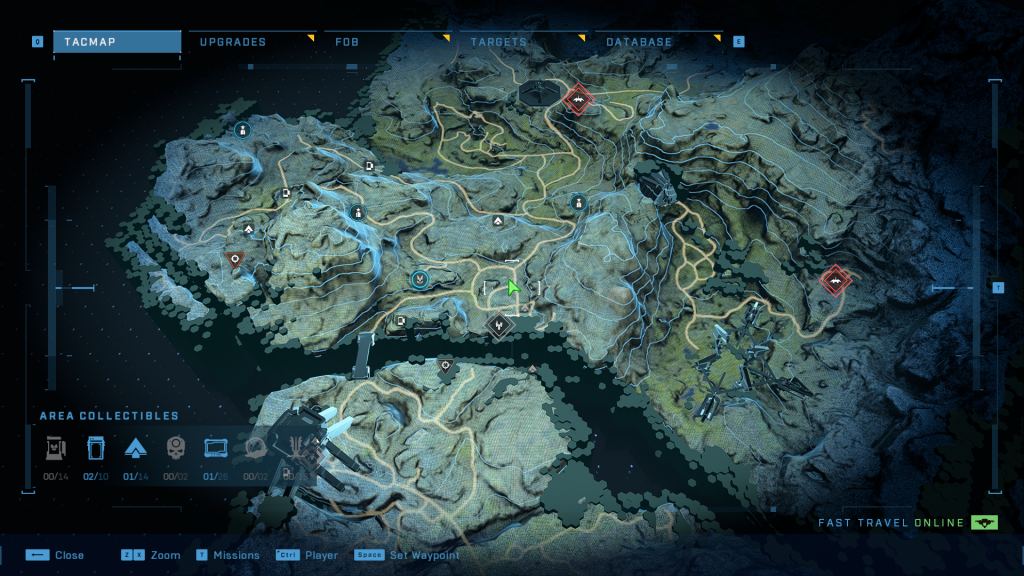
My experience with the open world varied. I liked the freedom it offered, allowing me to choose which objectives to tackle and the angles to attack them from, but I did feel that the decision to limit the game’s scope to one detailed region restrained the developers’ ability to explore a variety of alien and human habitats in traditional Halo fashion. Halo 2 and 3 swept the Master Chief from the Nordic idylls of the Halo rings to African cities under siege, covenant starships, and the gritty domains of the zombie Flood. Even Halo: Combat Evolved, which mostly stuck to its own Halo ring, had sections set in snowy regions and one in the terminally-purple innards of a covenant battle cruiser. Infinite‘s setting is far from boring, but my brain started feeling accustomed to its green and gray by the time I hit credits.
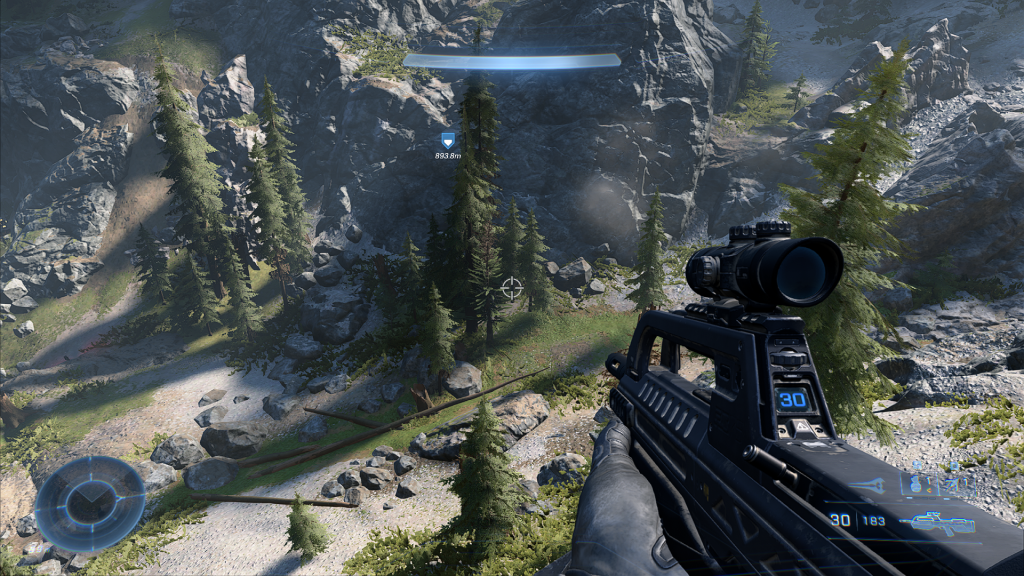
For these design imperfections, the experience I had within that open world was fantastic. Other critics might understandably lambast the samey feel of some of the outposts; at its dullest, clearing the ring of Banished foes is somewhat reminiscent of the subtle monotony of recent Far Cry games. That said, the formula works a lot better in Halo. Grappling in from a nearby mountain to wreak havoc on a Brute scrapyard fits Master Chief’s M.O. more than whichever annoying suburbanite the most recent Far Cry has you embody.
Simply taking these outposts on as a pedestrian Chief is satisfying enough, but the freedom of approach makes it special. Selecting from its decent arsenal of human and alien weapons is fun, but that’s normal. Calling in an aerial vehicle and charging in from the sky, filling up a 6-seater Razorback with rocket-wielding marines, grappling an explosive fusion coil toward you to throw it at the biggest guy in the yard, these are the experiences that make the game, and they’re lovely. My chief complaint has to be the lack of co-op. We’ve touched on it already, I’ve accepted it, we’ve collectively moved past it, but as special as these experiences are alone, I still find myself itching to replicate them with friends.
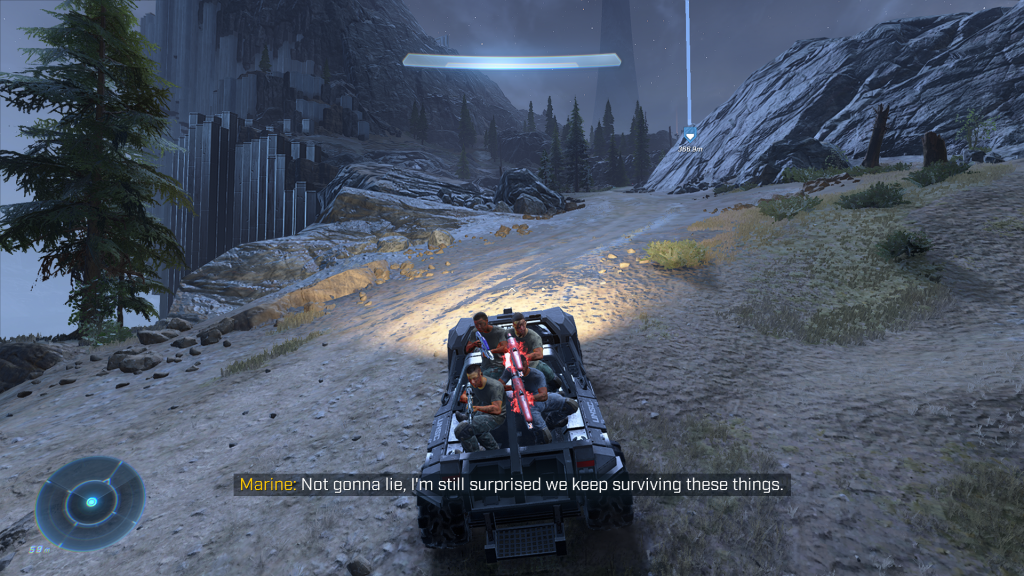
The Bad (Guys)
The enemies in Infinite are fun to fight. Each alien species feels a little better-defined compared to previous games. Brutes are more… brutal, displaying a sort of intentional ferocity that sets them apart from previous depictions as dumb angry apes. They operate according to honor and favor combat as a form of judgment. The agile and deadly elites, perhaps already the best-defined of the races, have their own interpretation of honorable combat, more the Bushido code of the Japanese Samurai than The Most Dangerous Game. They shout at the Chief when he relies on vehicles or unfair methods and try to goad him out into close quarters combat. The long-ranged jackals, still infuriating as ever with their penchants for sniper rifles, match their avian characteristics with predatory personalities that mesh well with the hunter-versus-hunted dogma of the Banished. And then there are the grunts. Long the fan favorites of the covenant’s battle ranks, the diminutive cannon fodder of the alien collective have always been leaned on for comedic relief, but never so effectively as here. They joke amongst themselves, deride the Master Chief unsuccessfully, and try to squirrel their way out of combat with grade school excuses. Their failures are glorious, successes knowingly accidental. They add flair to the game wherever they show up, perhaps best displayed in exchanges heard near propaganda towers, a sort of optional completion task requiring the Chief to take out antennas broadcasting the voice of the Banished. For the Chief, that voice is usually its leader, the brutal Escharum, who shows up to antagonize him in hologram form at all of the story’s major beats. For the regular rank-and-file soldiers of humanity and the UNSC, their Lord Haw-Haw is the Grunt Communications Officer, a hyper-confident, hyper-stupid broadcaster who’s… doing his best.
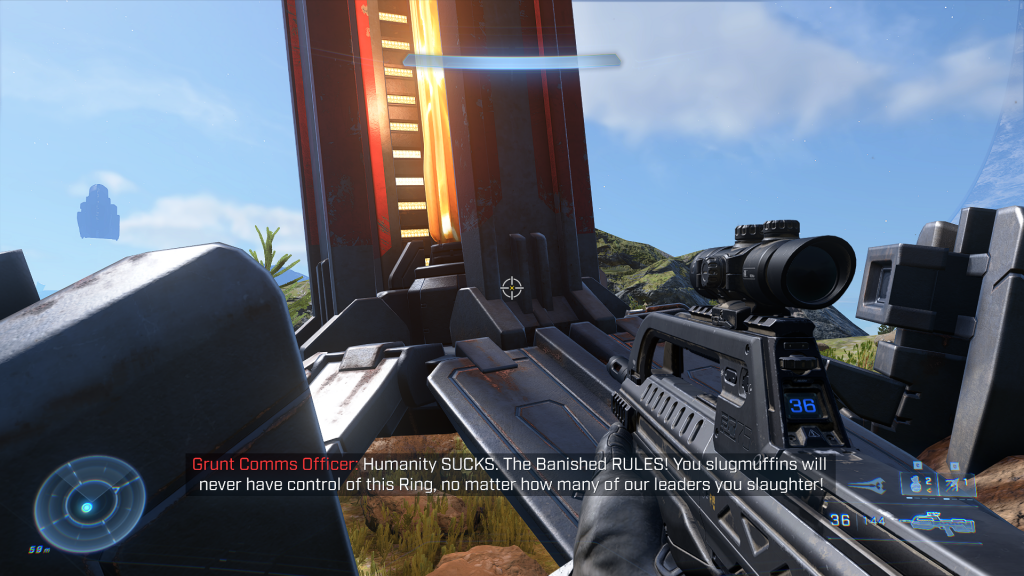
The gunplay and enemies make Infinite‘s campaign worthwhile. The story behind them is okay. Just like their alien counterparts, the Chief’s allies are great; Echo, the pilot who saves our hero from space, serves to humanize the eight-foot-tall warmachine, if only slightly, and the Weapon, the game’s Cortana stand-in, is a worthy replacement. There’s a little more faltering on the narrative side, where exposition is delivered primarily through holographic Twitter rants where alpha bro Escharum talks up how legendary the eventual fight between he and the Chief will be. I didn’t mind this method of storytelling as much as some, but it is an unfortunate avenue to disseminate as much information as the game needs to. Here are the (relatively spoiler-free) basics: Chief was given a mission to bring The Weapon to the ring to destroy Cortana, but this isn’t where the game starts. By the time the (playable) Chief wakes up in his new friend’s Pelican, the war is over. The leader of the Banished, Atriox, is dead, but his death was a pyrrhic victory for the Chief and his allies; the humans lost, and the Banished maintain control of the ring. Unfortunately, the Master Chief has narrative amnesia and needs to be reminded about what went down. His two mentors are The Weapon, an AI who doesn’t really know, and Escharum, an adversary who doesn’t really care. And at the end of two trilogies of not asking questions, our almost-silent protagonist sure as shit isn’t starting now.
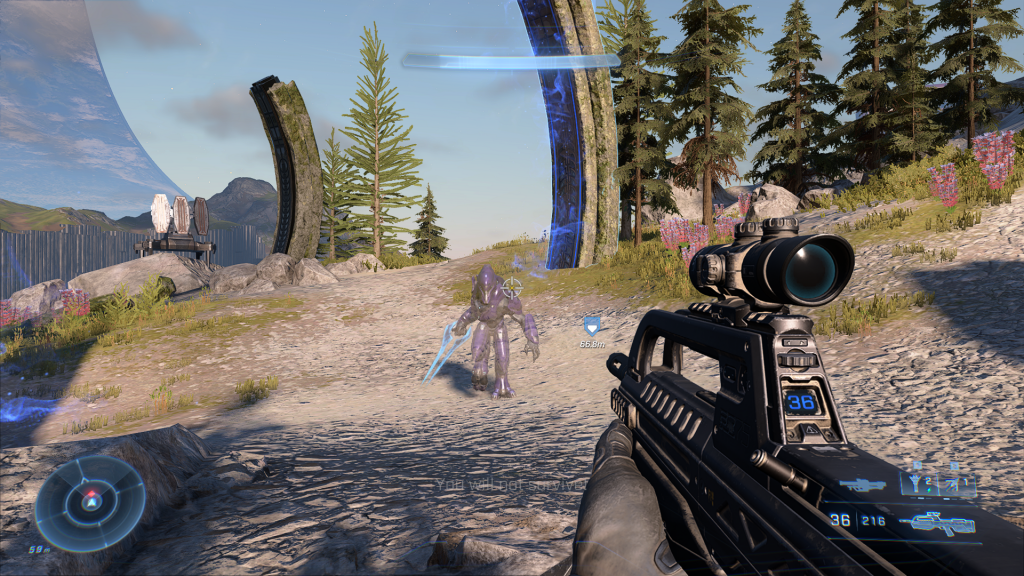
I didn’t have as much trouble as I thought I might have in accepting The Banished as Infinite‘s big bad guys. Promotional material labeled them the dudes bad enough to be kicked out of the Covenant, which makes them worthy villains individually, but I’m more intimidated by the Army than a gang of dishonorably discharged soldiers. The game doesn’t offer them a ton more characterization beyond what’s on the tin, but there’s more than enough to cement them as formidable baddies and to break them free of the Covenant mold, which is somewhat refreshing despite not really casting a new light on any of the constituent species (Brutes are brutal, Elites are honorable, grunts are silly; these depictions are stronger than ever before, but there’s still little nuance — they’re all just mean).
I think what the story lacks is a sense of narrative scale. We’re led to believe that the Banished are a universal, existential threat, but I might have preferred them to have been downplayed. The Covenant were a galaxy-spanning theocracy with a death wish and almost limitless resources to put toward its fulfillment. Comparatively, the Banished are more conventional and more limited. I think it might have been interesting for the story to have given us an aging Master Chief set against that more conventional and restricted but resourceful enemy that, against the odds, still won, making them a sort of foil of the human-elite alliance in Halo 3.
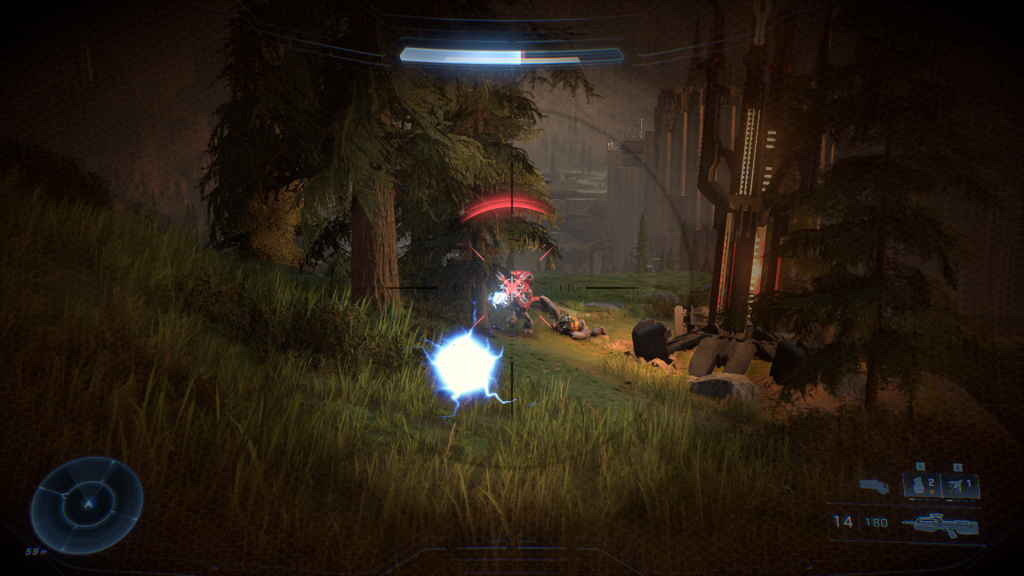
Conclusion
I think Halo Infinite is the sort of game that deserves two reviews, one now and one a year from now. What I have played is solid, and for a free-to-play multiplayer and a campaign that can be fully digested with a month of Game Pass, both are easy recommendations — if they sound interesting, give ’em a shot. Worst case scenario, you lost half an hour to multiplayer and $10 to the Game Pass sub. Play Psychonauts or DOOM or Stardew Valley instead. But as easy as that is, I feel like it’s still a tenuous recommendation because of the path the developers have chosen. Halo Infinite was designed to change, and the expectation of change puts a lot of pressure on 343 Industries’ shoulders. Their history with that sort of pressure is variable. In the past, they’ve both flubbed horrendously (The Master Chief Collection‘s original launch) and come close to overachieving (The Master Chief Collection‘s PC release).
Right now, I am hopeful for Forge and for campaign co-op. I am slightly worried for the future of Infinite‘s multiplayer progression system and for its paid cosmetics. At launch, 343 seemed poised to continue delivering valuable content updates. Unfortunately, launching so close to the holiday season makes it difficult to tell how frequent those updates will be in a normal month.
As it stands, this is a game I really enjoyed and one that I think can become a veritable titan of the modern gaming market with a little bit of work where it matters. Custom maps, campaign co-op, and a little bit of love will make this one my friends and I keep coming back to. But until then, I’ll settle for a session or two a week. It’s more than fun enough for that.
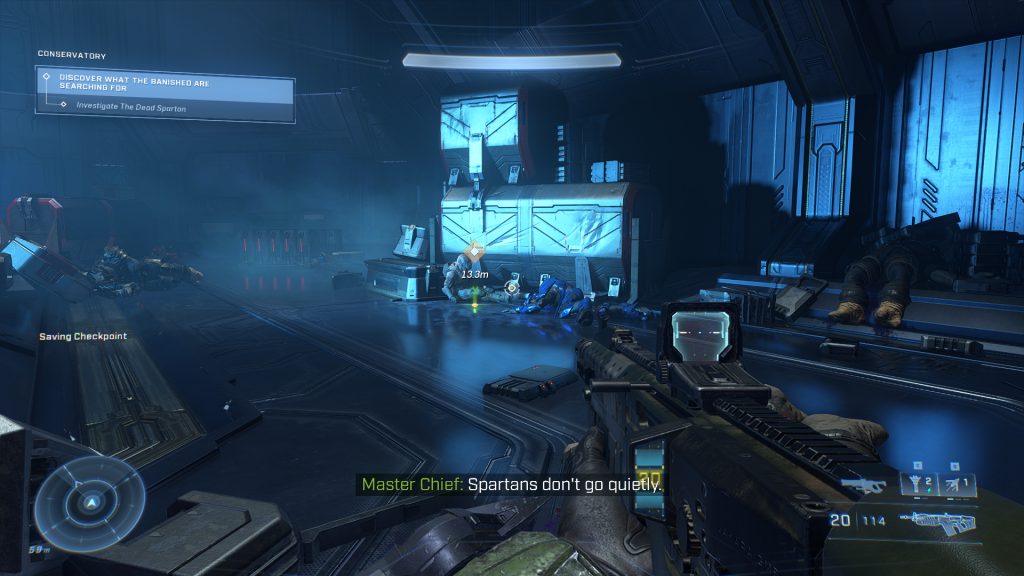
Quick Review
Game: Halo Infinite
Developer: 343 Studios
Published by: Microsoft
Available for: Windows PC, Xbox One, Xbox Series X/S
CONTENT
Microtransactions: Cosmetic*
Tedium: None mandatory — optional cosmetic and upgrade crates can be found throughout the campaign mode, and multiplayer’s challenges can be tedious to complete, but neither are necessary for enjoyment or performance.
Violence: Moderate — In the single-player campaign: gun and physical combat against alien enemies with some blood effects but no additional gore. In multiplayer: gun and physical combat against human spacemen with minimal blood and no gore.
Content: Mild language
*Real world currency can be used to buy cosmetic items directly, but the game also sells experience boosters and challenge skips (detailed above). I retained the “Cosmetic” rating because all experience and challenge rewards are still cosmetic in nature.
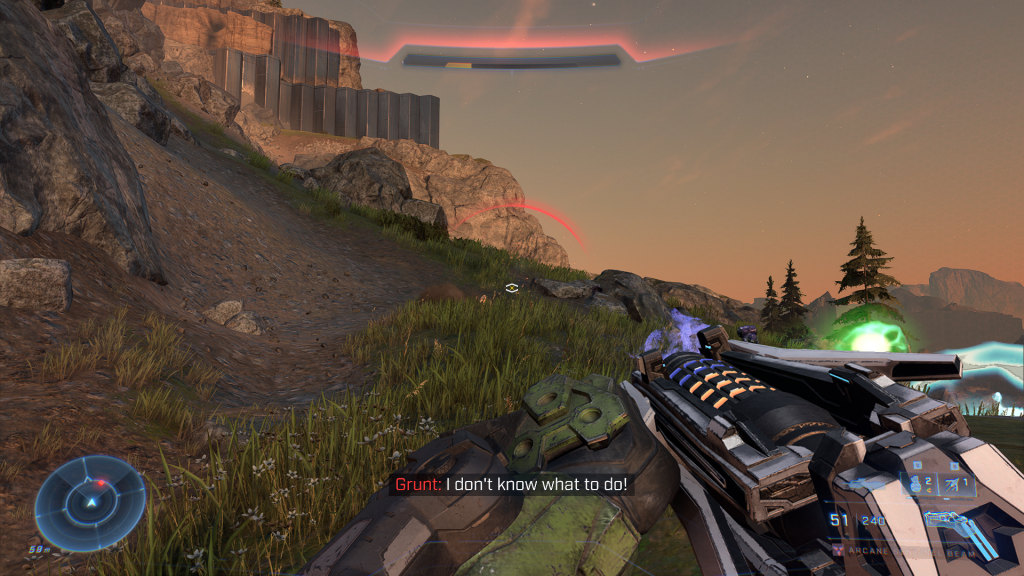
FEATURES
- First-Person Shooter Gameplay
- Open-World Single Player Campaign
- Revitalized Formula – Halo Infinite feels how a Halo game released in 2022 should, without sacrificing too much of its core appeal.
- Free-to-Play Multiplayer
WHAT I LIKED
- Mobility – Flying around the open world with the grappling hook is fun, and the sort of twist Halo benefits from.
- Flexibility – Infinite‘s campaign lets you play at your own pace, picking up side objectives and taking out enemy bases with a strategy of your choosing. Alternatively, stick to the main story and leave the side stuff in the dust.
- Multiplayer – The game does more than enough to satisfy die-hard Halo fans without relying too much on the old formula. Matches feel fun, responsive, and rewarding.
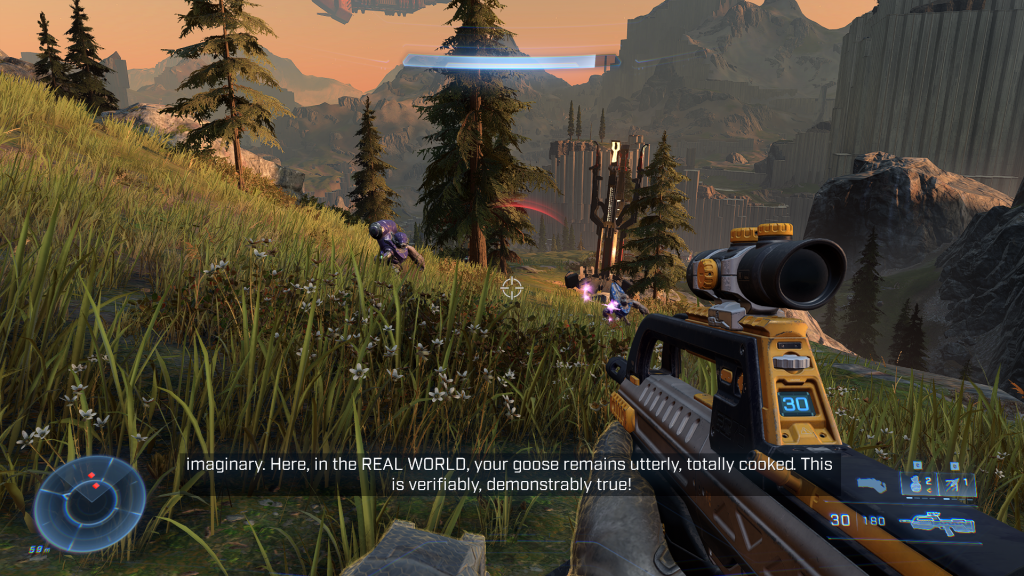
CONCERNS
- Missing Features – Longtime fans will miss features like Forge and Campaign Co-op. Both have been promised for future updates, but we’ve yet to receive a concrete timeline for their additions.
- Free-to-Play Tradeoffs – Adopting a free-to-play model means the money has to be made elsewhere. Halo Infinite‘s microtransactions are all cosmetic or cosmetic-adjacent, but their inclusion weighs down what is otherwise a strong (independent) multiplayer.
- Inconsistent Communication – Halo Infinite is fun as is, but much more compelling is the game it has the potential to be a year down the line. The planned features and additions promised and hinted at by the developers paint a picture of Halo‘s magnum opus. But mixed messages and plenty of missed deadlines cast some doubt on the accuracy of this image.
WHO’S IT FOR?
First, if you’re a Halo fan, it’s hard not to recommend this game. That said, if you’re one (of many) who gets most of your enjoyment out of co-op or forge, you might want to wait until those features are added later on. If you’re more about the multiplayer, it’s the best (new) Halo in years.
If you’re not already attuned to the Halo universe, but you’re interested in a somewhat tactical and futuristic multiplayer shooter, you don’t have much to lose by giving this (free!) game a try.
The game’s $60 campaign is a little tougher to recommend. If you’ve already got a game pass subscription or are entertaining picking one up for this title, I think I got more than my money’s worth. Roaming around the open world Halo, coming up with new ways to take out alien bases, and finishing the finished fight were easily worth it for me. For $60? I might wait for a sale or for co-op.
